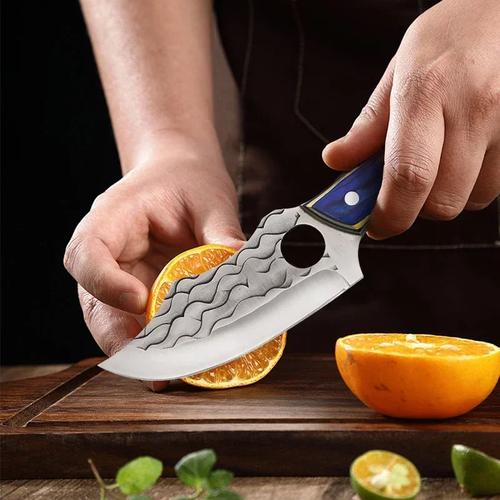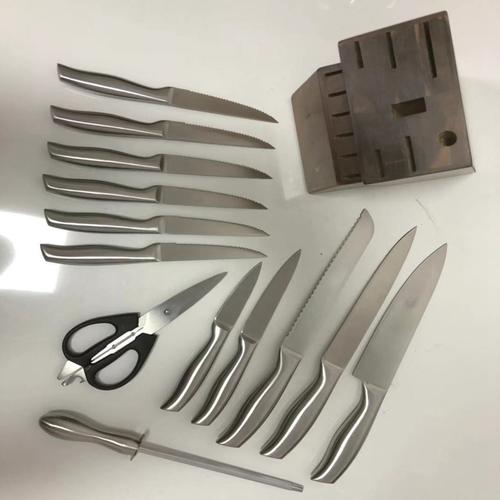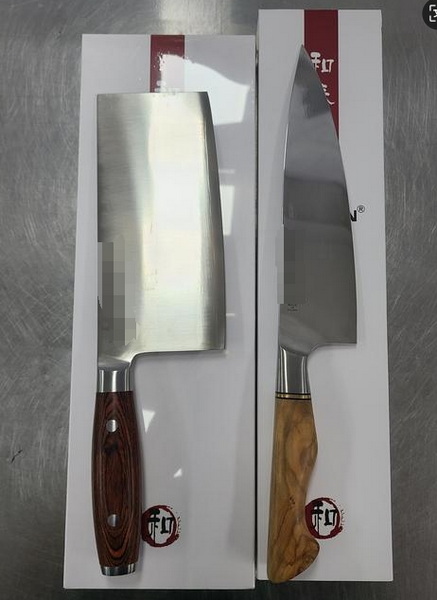

Views: 222 Author: Ella Publish Time: 2025-04-30 Origin: Site








Content Menu
● Understanding Your Cooking Style
>> Blade Length
>> Edge Type
● Types of Chef Knives: Western vs. Japanese
● Blade Materials and Construction
>> Steel Types
● Choosing the Right Size and Weight
● Best Chef Knives for Different Cooks
● How to Test a Chef Knife Before Buying
● Chef Knife Accessories and Upgrades
● Common Chef Knife Mistakes to Avoid
>> 1. What is the most important factor when choosing a chef knife?
>> 2. Should I choose a Western or Japanese chef knife?
>> 3. How often should I sharpen my chef knife?
>> 4. Is a forged knife better than a stamped knife?
>> 5. What size chef knife is best for beginners?
Selecting the right chef knife is one of the most crucial decisions for anyone passionate about cooking, whether you're a home chef or a professional. The perfect chef knife isn't just a tool-it's an extension of your hand, influencing your speed, precision, safety, and overall enjoyment in the kitchen. With a vast array of options available, understanding how to choose the ideal chef knife for your unique cooking style can seem overwhelming. This comprehensive guide will explore every aspect of chef knife selection, from blade types and materials to comfort, maintenance, and expert recommendations, helping you make an informed, confident choice.

A chef knife is the workhorse of the kitchen-a versatile, all-purpose blade designed for chopping, slicing, dicing, and mincing a wide range of ingredients. Typically ranging from 6 to 12 inches in length, chef knives feature a broad, curved blade that allows for a rocking motion during cutting, making them ideal for everything from mincing herbs to breaking down large cuts of meat.
Chef knives are distinguished by their adaptability. Whether you're preparing vegetables, slicing meat, or even crushing garlic, a good chef knife can handle it all. This versatility makes it the centerpiece of any kitchen knife collection.
Before diving into the technical details, it's essential to reflect on your cooking habits and preferences. Ask yourself:
- Do you cook daily or only on weekends?
- Are your meals mostly plant-based, or do you often work with meat and fish?
- Do you enjoy intricate, precise knife work, or do you need a blade that can handle heavy-duty tasks?
Your answers will guide you toward the chef knife that best matches your needs. For example, a vegetarian home cook may prioritize a lighter, thinner blade for delicate slicing, while a meat lover might need a heavier, more robust knife for butchery tasks.
When choosing a chef knife, focus on these critical features:
- Blade Material: Stainless steel, carbon steel, or a hybrid.
- Blade Construction: Forged vs. stamped.
- Blade Length: Usually 6–10 inches for most home cooks.
- Handle Comfort: Material, shape, and fit in your hand.
- Balance and Weight: Should feel natural and stable.
- Edge Type: Straight, hollow ground, or granton edge.
- Maintenance Needs: How often it needs sharpening and care.
- Stainless Steel: Resists rust and corrosion, low maintenance, but may require more frequent sharpening.
- Carbon Steel: Holds a sharp edge longer, easier to sharpen, but prone to rust if not properly cared for.
- High-Carbon Stainless Steel: Offers the best of both worlds-sharpness retention and corrosion resistance.
- Forged Blades: Made from a single piece of steel, heated and shaped. They are stronger, more balanced, and durable.
- Stamped Blades: Cut from a sheet of steel, lighter and typically less expensive, but may lack the heft and balance of forged knives.
- 6–8 Inches: Best for most home cooks-versatile, easy to control, and suitable for a variety of tasks.
- 8–10 Inches: Preferred by professionals or those who handle larger ingredients.
- 10–12 Inches: For breaking down large cuts of meat or professional use.
- Material: Wood, plastic, composite, or metal.
- Shape: Should fit comfortably in your hand with a secure grip.
- Balance: A well-balanced knife reduces fatigue and increases control.
A good chef knife should feel balanced between the blade and handle. The weight should be enough to cut through dense ingredients but not so heavy that it causes fatigue during long prep sessions.
- Straight Edge: Precise cuts, suitable for most tasks.
- Hollow Ground: Reduces friction, prevents food from sticking.
- Granton Edge: Scalloped sides for easy slicing of sticky foods.
Chef knives can be broadly categorized into Western and Japanese styles, each with unique characteristics.
| Feature | Western Chef Knife (German/French) | Japanese Chef Knife (Gyuto/Santoku) |
|---|---|---|
| Blade Shape | Curved edge, thicker blade | Straighter edge, thinner blade |
| Steel Hardness | Softer (55–58 HRC) | Harder (59–63 HRC) |
| Weight | Heavier | Lighter |
| Cutting Motion | Rocking | Up-and-down, push/pull |
| Maintenance | More forgiving, easier to sharpen | Holds edge longer, more brittle |
| Best For | Meat, root vegetables, all-purpose | Precision, vegetables, fish |
- German/French Origin
- Curved blade for rocking motion.
- Durable, versatile, and resistant to chipping.
- Ideal for heavy-duty tasks, including cutting through bones and dense vegetables.
- Gyuto, Santoku, Nakiri, etc.
- Thinner, lighter, and sharper blades.
- Designed for precision and delicate slicing.
- Best for vegetables, fish, and boneless meats.

- Stainless Steel: Most common, rust-resistant, easy to maintain.
- High-Carbon Stainless Steel: Combines sharpness and durability with corrosion resistance.
- Carbon Steel: Exceptional sharpness, easy to sharpen, but requires careful maintenance to prevent rust.
- Laminated/Damascus Steel: Multiple layers for strength and aesthetics; often features a hard core with softer outer layers for durability and easy sharpening.
- 55–58 HRC: Softer, more durable, easier to sharpen, but loses edge faster (typical of Western knives).
- 59–63 HRC: Harder, sharper, holds edge longer, but more brittle and prone to chipping (common in Japanese knives).
- Full Tang: Blade steel runs the entire length of the handle, offering superior balance and strength.
- Partial Tang: Blade steel only extends partway into the handle, less durable, often found in cheaper knives.
The ideal chef knife size depends on your hand size, comfort, and typical kitchen tasks.
- 6–8 Inches: Best for most home cooks and those with smaller hands.
- 8–10 Inches: Provides more leverage and is suitable for larger hands or heavier tasks.
- Weight: Should feel substantial but not cumbersome. Try different knives to find the best balance for you.
A comfortable handle is essential for safety and control.
- Material: Wood (classic, but requires more care), plastic (lightweight, dishwasher-safe), composite (durable, comfortable), metal (hygienic, but can be slippery).
- Shape: Should fit your grip naturally. Some handles have ergonomic curves or thumb rests for added comfort.
- Balance: The knife should feel evenly weighted between the blade and handle.
Proper care extends the life of your chef knife and keeps it performing at its best.
- Sharpening: Regular honing with a steel rod maintains the edge. Sharpen with a whetstone or professional service as needed.
- Cleaning: Hand wash and dry immediately. Avoid dishwashers, which can damage the blade and handle.
- Storage: Use a knife block, magnetic strip, or blade guard to protect the edge and prevent accidents.
- Oiling: For carbon steel knives, apply a light coat of oil to prevent rust.
Here are some top recommendations for various cooking styles and budgets:
- Best Overall: MAC Mighty MTH-80 – sharp, lightweight, excellent edge retention.
- Best Japanese-Style: Misono 440 Molybdenum Gyuto – precise, agile, and sharp.
- Best Western-Style: Wüsthof Classic Ikon – durable, balanced, and versatile.
- Best for Beginners: Victorinox Swiss Classic Chef's Knife – affordable, reliable, and easy to use.
- Best Upgrade: Miyabi Birchwood – elegant, high-performance, and beautiful craftsmanship.
Whenever possible, test a chef knife in person:
1. Grip the handle: It should feel comfortable and secure.
2. Check the balance: Hold the knife at the bolster (where blade meets handle). It should balance horizontally.
3. Simulate cutting: Try a rocking motion and see if the blade moves naturally.
4. Assess weight: It should feel substantial but not heavy.
5. Edge sharpness: Carefully test the edge on a piece of paper or soft vegetable (if allowed).
To get the most out of your chef knife, consider investing in these essential accessories:
- Honing Steel: Keeps your knife's edge aligned between sharpenings.
- Whetstone: For periodic sharpening and edge maintenance.
- Knife Block or Magnetic Strip: Safe and convenient storage.
- Blade Guards: Protect the edge when storing knives in drawers.
- Cutting Board: Use a wooden or plastic board to preserve your knife's edge-avoid glass or ceramic boards.
Even the best chef knife can underperform or become damaged if misused. Here are some common mistakes to avoid:
- Using the wrong cutting board: Hard surfaces like glass or stone can dull or chip your blade.
- Improper cleaning: Dishwashers and soaking can damage both blade and handle.
- Neglecting regular maintenance: Failing to hone or sharpen your knife leads to poor performance and unsafe cutting.
- Using the knife for non-food tasks: Avoid using your chef knife to open cans, cut bones (unless it's designed for it), or pry open jars.
- Incorrect storage: Tossing knives in a drawer can dull the edge and pose safety risks.
Choosing the right chef knife is a personal journey shaped by your cooking style, hand size, and preferences. By understanding the key features-blade material, construction, size, comfort, and maintenance-you can invest in a knife that will transform your kitchen experience. Remember, the best chef knife is the one that feels like a natural extension of your hand, making every slice, dice, and chop a pleasure. With proper care and the right accessories, your chef knife can last a lifetime, elevating your cooking and inspiring creativity in the kitchen.

The most important factor is comfort and balance. The knife should feel natural in your hand, with a handle that fits your grip and a weight that suits your strength and cutting style.
Choose a Western-style knife if you prefer a heavier, more durable blade for tough tasks. Opt for a Japanese-style knife if you value precision, sharpness, and often prepare vegetables or fish.
Hone your knife regularly with a steel rod to maintain the edge. Depending on usage, sharpen it with a whetstone or professional service every few months.
Forged knives are generally stronger, more balanced, and longer-lasting than stamped knives. However, stamped knives can be lighter and more affordable, making them suitable for some home cooks.
An 8-inch chef knife is the most versatile and recommended size for beginners. It offers a good balance of control and cutting power for most kitchen tasks.